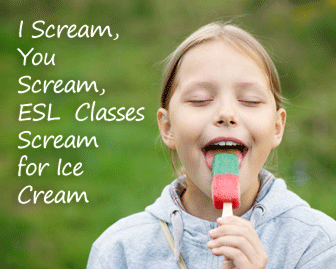I Scream, You Scream, ESL Classes Scream for Ice Cream


Here are some activities just perfect for midsummer classes.

July 4th is Independence Day in the U.S. It commemorates the declaration of a new country, a country that eventually became the United States of America. With that in mind, create a vocabulary web with your students with independence as its theme. Start by writing the word independence in the center of your board and putting a circle around it. Then, ask students to add words to the web that they associate with independence. These words should be like spokes off the center word. As you continue your discussion, add words related to the second layer words. For example, a student might suggest parents as a second tier word because young people want to gain independence from their parents. You might then add spokes off “parents” such as home, finances, marriage, etc. Add your own words to the web, too. You will end up with a large selection of related vocabulary words that your students can then use as a resource as they write an essay about independence.
What does it mean to your students to be free? The answer might depend on their home cultures and their personal values. Ask your students to write a paragraph or two explaining what freedom means to them. Do they feel as though they are free? Is freedom something they would be willing to fight for? What freedoms are most important? After your students complete their paragraphs have a class discussion with the same questions.
In the U.S., July 4th is traditionally celebrated with fireworks. Have your student seen fireworks before? Ask volunteers to share about their experience with the class. Then have all your students either discuss with a partner or write a short paragraph about a specific time they saw fireworks. Where were they? What did they see? How did they feel? How did the people around them react? If possible, have a class trip to see fireworks around the fourth or encourage students to see this year’s fireworks on their own. Afterward, show students how to write a simile – by comparing two things using the word like or as. Have your class write a list of similes describing what it was like to see the fireworks. (E.g. The fireworks were as loud as thunder.)
July is Anti-Boredom month, and as a teacher you are probably never bored. Your students, on the other hand, might not have the same level of business in their lives. As a class, brainstorm different activities a person might do when they are bored. Feel free to add your own ideas to the list and introduce your students to some new vocabulary. After the discussion, have each person choose their top five activities to prevent boredom. They should list those activities along with a short explanation of why they chose each one.
July is one of the hottest months of the year in the U.S., and it’s only natural that it would also be Ice Cream Month. The frozen treat is a favorite for parties and snacks in the blistery summer heat. Ice cream is more than just vanilla, chocolate, and strawberry these days. In fact, you can find flavors as unusual as jalapeno and bacon. Give your students a real example of an unusual ice cream flavor by bringing in a pint of Ben & Jerry’s or other specialty ice cream. If you like, hand out spoons and let everyone in class take a taste. Then set your students thinking. What creative ice cream flavors of their own can they come up with? Have students imagine the perfect ice cream flavor, one that no one has ever made before. Students should write a short description of their flavor such as you would find on a pint of specialty ice cream. They can use the one you brought in as an example. Then compile all the descriptions into a menu of class flavors and make copies for your students. Take a vote on which flavor other than their own students would most like to eat. Give the winner, you guessed it, a pint of ice cream.
The dog days of summer are here once the calendar flips to July, and young and old can do many activities that they cannot do in colder weather. Perhaps that is why July is National Recreation Month. Have groups of three of four students list as many summer only activities as they can. Then, have each person choose one activity from the list that they have never done before. Your students should write a paragraph which explains either why they would like to do that activity or why they would not like to do that activity. If possible, pair each person with someone who has done that activity and let the inexperienced person ask his partner questions.
Did you know that July 12 is paper bag day? It commemorates the day the paper bag machine was patented. Paper bags are great for getting students talking. To celebrate the day, give each student a plain brown paper bag. For homework, students should choose an object that will fit in the bag and bring it into school the next day. Give everyone an opportunity to show his or her bag to the class without revealing the contents of the bag. Students in the class can ask yes/no questions about the object in the bag to try and determine what it is. They only get twenty questions. If they can guess the object, the class wins. If they cannot guess, the presenter wins.
A paper bag is versatile, inexpensive, and convenient. Have students work in groups of three to write a list of as many uses for a paper bag as they can. After groups have had enough time to discuss, have each group share two or three of their most original ideas for using paper bags with the entire class.
July 16, 2014 is World Snake Day. Do any of your students keep snakes as pets? Are any of them afraid of snakes? Do they know that ophidiophobia is an irrational fear of snakes? Use World Snake Day to introduce your class to the idea of a phobia or fear of something. You can point out that the root word phobia is used in the names of many fears. Have your class list as many fears as they can and then look up the scientific name for the fear of that item. You can then talk about the word roots in these other fears as well.
Do any of your students have a fear of snakes? Are they afraid of heights? Water? The number 13? On or near World Snake Day, challenge your students to face their fears. Have students write a paragraph about something that scares them, why it scares them, and what they could do to face their fear.